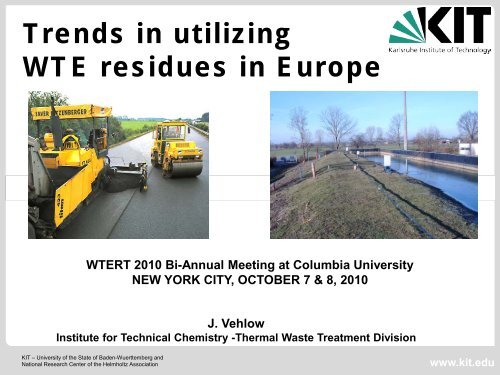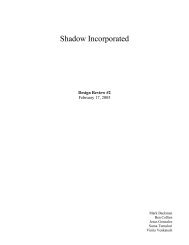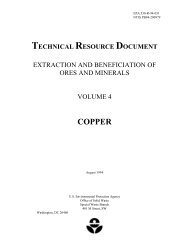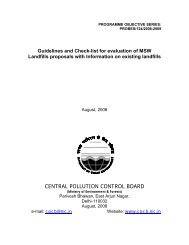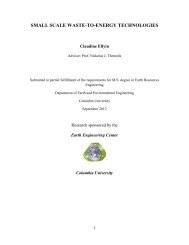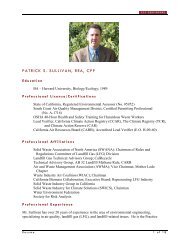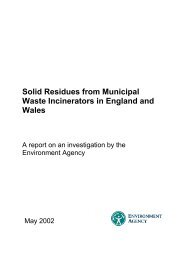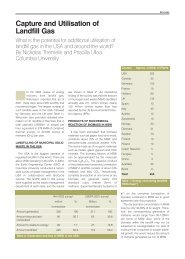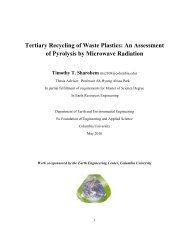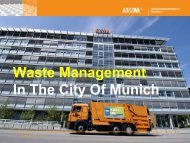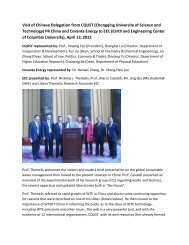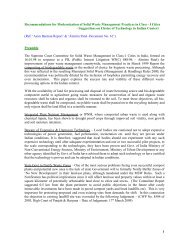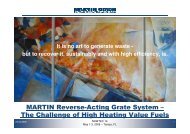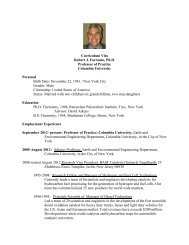Dr. Juergen Vehlow - Columbia University
Dr. Juergen Vehlow - Columbia University
Dr. Juergen Vehlow - Columbia University
- No tags were found...
You also want an ePaper? Increase the reach of your titles
YUMPU automatically turns print PDFs into web optimized ePapers that Google loves.
TECHNIQUE Shimadzu News 2/2005All roads lead to Rome –Absorbance (mAU)10864201. Uracil2. Phenol3. Methyl Paraben4. Ethyl Paraben5. Propyl Paraben6. Butyl Paraben7. Heptyl Paraben1234567605040302010B Concentration (%)Absorbance (mAU)4003002001001. Nitromethane2. Anthracene3. Pyrene4. Perylene1123243430 °C60 °C- 2 00.0 0.2 0.4 0.6 0.8 1.0MinutesFigure 1: Shark Fin Gradient TM00 2 4 6 8 10MinutesFigure 2: Temperature effect for the separation of a compoundConditions: Column type: Pathfinder EP Fast 3 µm · Column size: 4.6 x 33 mmFlow rate: 4.5 mL/min · Mobile phase: A: Water, B: AcetonitrileGradient: 12 - 55 % B over 36 seconds (non-linear) · Temperature: 60 °CDetection: UV detector 254 nm, 10 Hz, 50 °C flow cellConditions: Column type: Pathfinder AS100 3.5 µm · Column size: 4.6 x 150 mmFlow rate: 1.0 mL/min · Mobile phase: Isocratic Water/Acetonitrile 10 % : 90 %Detection: UV detector 254 nmNot only is everythinggetting faster – it alsohas to get better. In ourdaily life and in our professions.And, not to be forgotten, in thelaboratory with respect to HPLCanalysis and its results. But whichHPLC system parameter can beadjusted in order to obtain betterresults faster?To start out …When the flow rate is increased,individual components are elutedfaster from the column, whichin itself should be positive. Buthigher flow rates lead to increaseduse of organic solvents and theirdisposal, leading in turn to highercosts. For flow rates differingfrom the standard flow rates, thepossibilities of modern columntechnology and the trend towardsminiaturization should be takeninto account.SecondShorter columns, smaller columndiameters or the use of smallerstationary phase particle sizes candecrease retention times withoutthe loss of separation performance(equal or larger number oftheoretical plates). However,smaller particles result in higherbackpressures, which in turn cancause leaks in the system withconsequences for the robustnessand suitability for routine applications.ThirdThe mobile phase compositioncan be adjusted, depending on theapplication. From time to time,based on cost savings and simplifications,it is also advisable toconsider gradient elution. Optimizedgradients lead to decreasedretention times with resultantPressure (bar)30025020015010050Flow (mL/min)0 4.5 4.0 3.5 3.0 2.5 2.0 1.5 1.0Figure 3: Pressure curves at various column temperaturesreduction of solvent consumption.The implementation of nonlineargradients should also beconsidered on a case-by-casebasis. Non-linear gradients compensatefor the changing elutionstrengths of the organic solvent/watermixture in a lineargradient, and can often enableeven faster separation.Temperature (°C)Conditions: Column type: Pathfinder EP Fast 3 µm · Column size: 4.6 x 33 mmMobile phase: Isocratic Water/Acetonitrile 50 % : 50 %80706050403016
MSW1000furnace / boilerfilterscrubber< 0.052 - 57 – 15Fe 20 - 30non Fe 5 - 15150 –2500.5 - 2(wetwith effluents)12 – 18(wet withouteffluents)20 – 40(dry)flows of solid masses in a MSWI plant in kgJ. <strong>Vehlow</strong> INSTITUTE FOR TECHNICAL CHEMISTRYTHERMAL WASTE TREATMENT DIVISION
fundamentals of WtE residue managementin Europe• almost uniform regulations for disposal (in EU based onCouncil Decision 2003/32/EC)• no common standards or recommendations for utilisation• bottom ashes are generally classified as non hazardous• depending on national regulations they are either landfilledor utilised• boiler ash and filter ashes are classified as hazardouswaste• APC residues are also classified as hazardous wasteJ. <strong>Vehlow</strong> INSTITUTE FOR TECHNICAL CHEMISTRYTHERMAL WASTE TREATMENT DIVISION
selected elements in bottom ash and lithosphereJ. <strong>Vehlow</strong> INSTITUTE FOR TECHNICAL CHEMISTRYTHERMAL WASTE TREATMENT DIVISION
important parameters for bottom ashmanagement• total organic carbon• chemical composition• leaching stability- access criterion for landfills- main quality parameter for utilisation• mechanical parameters in case of utilisationJ. <strong>Vehlow</strong> INSTITUTE FOR TECHNICAL CHEMISTRYTHERMAL WASTE TREATMENT DIVISION
selected leaching compliance teststest EN 12457-3EN 12457-2/DIN EN 12457-4TVA NEN 7243 NEN 7243country EU Germany Switzerland The Netherlands The Netherlandstype serial batch batch serial batch column serial batchmax- particlesize (mm)leachant H 2 O H 2 Onumber ofstepsL/S (l/kg)per stepcontact timeagitation10 actual size H 2 O 4 0.125CO 2 saturatedH 2 O1 mol/l HNO 31 st step: pH=72 nd step: pH=42 1 2 7 21 st step: 22 nd step: 81 st step: 6 h2 nd step: 18 hend over end/roller table10 10 0.1 - 10 5024 h 24 h per step ≈ 16 d 3 hend over end/roller tableCO 2 injectionleachantpumpedthrough columnstirringJ. <strong>Vehlow</strong> INSTITUTE FOR TECHNICAL CHEMISTRYTHERMAL WASTE TREATMENT DIVISION
CrNiCuZnCdPb0.001 0.01 0.1 1 10 100release in mg/kgTVA DIN EN 12457-4leaching of bottom ash using the Swiss and the German testJ. <strong>Vehlow</strong> INSTITUTE FOR TECHNICAL CHEMISTRYTHERMAL WASTE TREATMENT DIVISION
egulations for bottom ash managementin Germanydisposal• Ordinance on Environmentally Compatible Storage of Wastefrom Human Settlements (AbfAblV, 2001)utilisation• LAGA M19- investigation of raw bottom ash• LAGA M20- regulations for utilisation• leaflets of federal states,road construction regulations (FGVS),...J. <strong>Vehlow</strong> INSTITUTE FOR TECHNICAL CHEMISTRYTHERMAL WASTE TREATMENT DIVISION
German landfill and utilisation standardsparameterdimensionlandfill landfill utilisationclass 1 class 2 (LAGA M20)LOI % 3 5TOC % 1 3 1DIN EN 12457-4sol. fraction % 3 6el. cond. mS/m 1,000 5,000 600Cl mg/l 250Ni mg/l 0.2 1 1Cu mg/l 1 5 0.3Zn mg/l 2 5 0.3Cd mg/l 0.05 0.1 0.005Pb mg/l 0.2 1 0.05strengthvane shear strength kN/m 2 25 25 25axial deformation % 20 20 20uniaxial compr. strength kN/m 2 50 50 50J. <strong>Vehlow</strong> INSTITUTE FOR TECHNICAL CHEMISTRYTHERMAL WASTE TREATMENT DIVISION
HClwaterbottomashtankHCl pumpfiltertoscrubberwaterdeslaggerfiltertobunkerwaterpress.airsedimentationprocesswaterbottom ash washing at MVR HamburgJ. <strong>Vehlow</strong> INSTITUTE FOR TECHNICAL CHEMISTRYTHERMAL WASTE TREATMENT DIVISION
aw ash32 mmsieve10mm>10 mmimpactcrusher32 mmdisposaltofurnacestorage formaturingutilisation(source: Zwahr 2005)treatment of bottom ash for utilisation (Hamburg)J. <strong>Vehlow</strong> INSTITUTE FOR TECHNICAL CHEMISTRYTHERMAL WASTE TREATMENT DIVISION
importance of metal separationdrivers• unwanted effects in application (H 2 formation, swelling)• economy, esp. for non-ferrous metalsstatus• almost all plants practice ferrous scrap separation• most plants implement eddy current systems• conventional systems remove 60 – 70 % of ferrous and≈ 30 % of non ferrous scrap• many plants try to do special separation from fine fractions• in Switzerland dry ash discharge is consideredJ. <strong>Vehlow</strong> INSTITUTE FOR TECHNICAL CHEMISTRYTHERMAL WASTE TREATMENT DIVISION
←conveyer beltmagnetpermanentmagnetbottom ashconveyermagneticfractionmagneticfractionmagneticdrum separatornon-magneticfractionover-band systemdrum systemmagnetic separation systemsJ. <strong>Vehlow</strong> INSTITUTE FOR TECHNICAL CHEMISTRYTHERMAL WASTE TREATMENT DIVISION
eddy currentseparatorsensor operatedseparatornew metal separation systemsJ. <strong>Vehlow</strong> INSTITUTE FOR TECHNICAL CHEMISTRYTHERMAL WASTE TREATMENT DIVISION
DEV S4 results of bottom ash samplesJ. <strong>Vehlow</strong> INSTITUTE FOR TECHNICAL CHEMISTRYTHERMAL WASTE TREATMENT DIVISION
ottom ash management in selected countriesJ. <strong>Vehlow</strong> INSTITUTE FOR TECHNICAL CHEMISTRYTHERMAL WASTE TREATMENT DIVISION
ottom ash management in selected countriesyear production utilisation specifics[Mg/a] [%]Austria 2008 358,000 10 'slag concrete for landfill'Belgium 2008 490,000 100 secondary building materialCzech Republic 2008 100,000 0 landfillingDenmark 2008 631,000 99 80% road constructionFinland 2008 45,000 0 landfilledFrance 2008 2,700,000 80 civil engineeringGermany 2009 4,740,000 85 mainly road constructionHungary 2008 105,000 0 landfillingItaly 2008 827,310 50 landfillingNetherlands 2009 1,500,000 100 building materialNorway 2008 200,000 0 landfillingPortugal 2008 193,000 0 landfillingSpain 2005 293,693 5 road constructionSweden 2008 690,000 10 few cases of road constructionSwitzerland 2008 700,000 0 landfillingUnited Kingdom 2008 650,000 40 building materialJ. <strong>Vehlow</strong> INSTITUTE FOR TECHNICAL CHEMISTRYTHERMAL WASTE TREATMENT DIVISION
PCDD/Fconcentration in mg/kg (PCDD/F in ng[TE]/kg)selected pollutants in bottom and filter ashJ. <strong>Vehlow</strong> INSTITUTE FOR TECHNICAL CHEMISTRYTHERMAL WASTE TREATMENT DIVISION
filter ash managementproblem• high loads of salts, low volatile organics, and heavy metalsstatus• hazardous landfill still preferred disposal practise• so-called utilisation for- backfilling of salt mines in Germany- filling of an old quarry on Norwegian Island Langøya• utilisation as asphalt filler in The Netherlands• especially in Switzerland acid metal extraction (FLUWA)- option of thermal treatment of residues and metal recoveryJ. <strong>Vehlow</strong> INSTITUTE FOR TECHNICAL CHEMISTRYTHERMAL WASTE TREATMENT DIVISION
filter ash management in selected countriescountryyearproductioncomments[Mg]Austria 2004 40,000 mainly salt mine backfilling, hazardous landfillBelgium 2004 50,000 solidification and haz. landfillCzech Republic 2004 6,000 5000 hazardous landfill, 1000 underground mineDenmark 2004 86,834 100% recycled (salt mine after special treatment)France 400,000Germany 2005 650,000 utilisation in salt mine, minor amount haz. landfillHungary 2005 13,585 hazardous landfillItaly 2004 75,000 hazardous landfillNetherlands 2003 82,200 50% utilised in mines and as asphalt fillerPortugal 2005 40,000 inertisation before hazardous landfillSpain 2005 94,420 hazardous. landfillSweden 2004 138,000 landfilling. partly utilisation in Norway (Langoya)Switzerland 2008 70,000 metal extraction, landfillUnited Kingdom 2000 78,125 hazardous landfillJ. <strong>Vehlow</strong> INSTITUTE FOR TECHNICAL CHEMISTRYTHERMAL WASTE TREATMENT DIVISION
oilerfilter1. scrubber2. scrubberHg recoverygrate ash+ 3R productextractionbinderextrusionliquidheavy metal recoveryscheme of the 3R ProcessJ. <strong>Vehlow</strong> INSTITUTE FOR TECHNICAL CHEMISTRYTHERMAL WASTE TREATMENT DIVISION
APC residue managementproblem• high loads of salts• Hg• heavy metals & organics in case of dry scrubbing withoutseparate fly ash removalstatus• hazardous landfill still preferred disposal practise• so-called utilisation in mines• recovery of HCl and gypsum in few plantsJ. <strong>Vehlow</strong> INSTITUTE FOR TECHNICAL CHEMISTRYTHERMAL WASTE TREATMENT DIVISION


